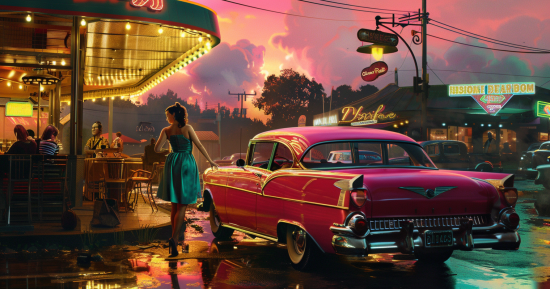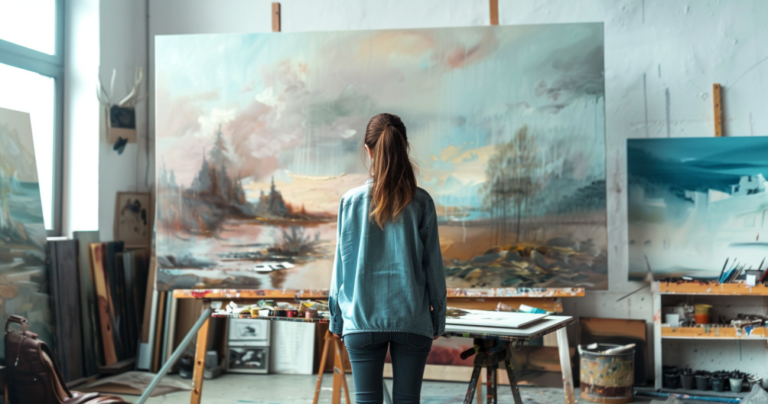Have you ever wondered why certain color combinations seem to pop and vibrate when placed side by side? That’s the magic of complementary colors in art! These dynamic duos can create striking visual effects and add depth to your artwork.
What Are Complementary Colors in Art
Complementary colors are hues that sit opposite each other on the color wheel. When used together, they create maximum contrast and vibrancy.
You’ll find red and green, blue and orange, and yellow and purple among these powerful pairings. Artists harness their energy to draw attention to specific elements or create a sense of balance in their compositions.

Understanding complementary colors can elevate your artistic skills and help you make more informed color choices. Whether you’re a painter, designer, or simply someone who appreciates art, exploring the world of complementary colors will open up new possibilities for your creative expression.
Let’s dive deeper into how you can use these color relationships to enhance your artwork and create visual impact.
Understanding Complementary Colors

Definition and Basic Theory
Complementary colors are pairs of hues that sit directly across from each other on the color wheel. These colors create maximum contrast and visual impact when placed side by side.
The three main complementary pairs are:
- Red and Green
- Blue and Orange
- Yellow and Purple
You’ll notice that each pair consists of one primary and one secondary color. Mixing complementary colors in equal amounts neutralizes each other, producing a gray or brown tone. This property makes them useful for creating shadows and muting bright hues in your artwork.
Color Wheel Dynamics
The color wheel is a crucial tool for understanding complementary colors. It visually represents the relationships between different hues.
Primary colors (red, blue, and yellow) are evenly spaced around the wheel. Secondary colors (green, orange, and purple) sit between them. To find a color’s complement, look directly across the wheel. This arrangement creates natural harmony and balance in your compositions.
You can use complementary colors to:
- Draw attention to specific elements
- Create depth and dimension
- Enhance the vibrancy of your palette
By adjusting the saturation and value of complementary pairs, you can achieve various effects, from subtle to bold. Embracing experimentation with these dynamics will help you develop a more nuanced understanding of color theory and foster a sense of curiosity and open-mindedness in your artistic practice.
Applying Complementary Colors in Art

Creating Contrast and Harmony
When placed side by side, complementary colors naturally create a strong contrast. This contrast draws the viewer’s eye and adds visual interest to your work.
To create harmony, try mixing complementary colors to produce muted tones. For example, mix a little green into red to create a subdued red hue. These muted shades can help balance bolder areas of your painting.

You can use complementary colors to make certain elements pop. For example, place a small area of orange against a predominantly blue background to create a focal point. Experiment with different ratios of complementary pairs. An 80:20 split often works well, with the dominant color covering most of the canvas and its complement used sparingly for accents.
Tips for Color Pairing and Usage

When working with complementary colors, start by choosing a base color for your palette. Then, identify its complement on the color wheel to create your pair.
Consider these tips for effective use:
- Use complementary colors in different proportions to avoid overwhelming the viewer
- Explore various tints and shades of your chosen pair for more subtle effects
- Try placing complementary colors next to each other for maximum impact
- Use one color as the background and its complement for foreground elements
You can also create a split-complementary scheme by using one color with the two colors adjacent to its complement. This provides a bit more variety while maintaining the energy of complementary pairs.
Remember to step back and assess your work periodically. Adjust the balance of colors as needed to achieve your desired effect.

Frequently Asked Questions – What Are Complementary Colors in Art
How can I identify complementary colors in a painting?
You can spot complementary colors by looking for high-contrast pairs that seem to vibrate or pop when placed next to each other. These colors are opposite each other on the color wheel. Common complementary pairs include red-green, blue-orange, and yellow-purple. To practice, try squinting at a painting. This technique helps blur details and emphasize color relationships, making it easier to identify complementary pairs.
What are some notable examples of complementary colors used in famous artworks?
Vincent van Gogh’s “The Starry Night” showcases a striking use of blue and orange complementary colors. The deep blue night sky contrasts beautifully with the warm orange of the stars and crescent moon. Claude Monet’s “Impression, Sunrise” employs a subtle orange-blue complementary scheme. The orange sun reflects off the water, standing out against the cool blue tones of the harbor.
How do primary colors relate to complementary colors?
Primary colors (red, blue, and yellow) form the basis for complementary color pairs. Each primary color complements the secondary color created by mixing the other two primaries. For instance, red complements green (made by mixing blue and yellow). Blue is complementary to orange (red + yellow), and yellow is complementary to purple (red + blue).
What is the visual impact of using complementary colors in art?
Using complementary colors in art creates a powerful visual effect. These color pairs produce high contrast and vibrant interactions, enhancing readability and viewer engagement. Complementary colors can make specific elements stand out, create depth, or evoke certain emotions. They can also add energy and dynamism to a composition, drawing the viewer’s eye to key focal points.






